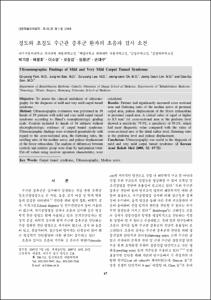KUMEL Repository
1. Journal Papers (연구논문)
1. School of Medicine (의과대학)
Dept. of Rehabilitation Medicine (재활의학)
경도와 초경도 수근관 증후군 환자의 초음파 검사 소견
- Keimyung Author(s)
- Lee, So Young; Lim, Jeong Geun; Son, Dae Gu
- Department
- Dept. of Rehabilitation Medicine (재활의학)
Dept. of Neurology (신경과학)
Dept. of Plastic Surgery (성형외과학)
- Journal Title
- 대한재활의학회지
- Issued Date
- 2008
- Volume
- 32
- Issue
- 1
- Abstract
- Objective: To assess the clinical usefulness of ultrasonography
for the diagnosis of mild and very mild carpal tunnel
syndrome.
Method: Ultrasonographic evaluation was performed in 39
hands of 29 patients with mild and very mild carpal tunnel
syndrome according to Bland's neurophysiologic grading
scale. Controls included 41 hands of 34 subjects without
electrophysiologic evidence of carpal tunnel syndrome.
Ultrasonographic findings were evaluated quantitatively with
regard to the cross-sectional area, the flattening ratio, the
swelling ratio of the median nerve, and palmar displacement
of the flexor retinaculum. The analysis of differences between
controls and patients group were done by independent t-test.
Cut-off values using receiver operation characteristic, were
calculated.
Results: Patients had significantly increased cross sectional
area and flattening ratio of the median nerve at proximal
carpal area, palmar displacement of the flexor retinaculum
at proximal carpal area. A critical value of equal or higher
to 8.5 mm2 for cross-sectional area at the pisiform level
showed a sensitivity 79.5%, a specificity of 95.1%, which
had most diagnostic value compared with the value of
cross-sectional area at the distal radius level, flattening ratio
at the pisiform level and palmar displacement.
Conclusion: Ultrasonography was useful in the diagnosis of
mild and very mild carpal tunnel syndrome.
- Alternative Title
- Ultrasonographic Findings of Mild and Very Mild Carpal Tunnel Syndrome
- Publisher
- School of Medicine
- Citation
- 박기영 et al. (2008). 경도와 초경도 수근관 증후군 환자의 초음파 검사 소견. 대한재활의학회지, 32(1), 67–72.
- Type
- Article
- ISSN
- 1225-584X
- 파일 목록
-
-
Download
 oak-bbb-3443.pdf
기타 데이터 / 464.42 kB / Adobe PDF
oak-bbb-3443.pdf
기타 데이터 / 464.42 kB / Adobe PDF
-
Items in Repository are protected by copyright, with all rights reserved, unless otherwise indicated.